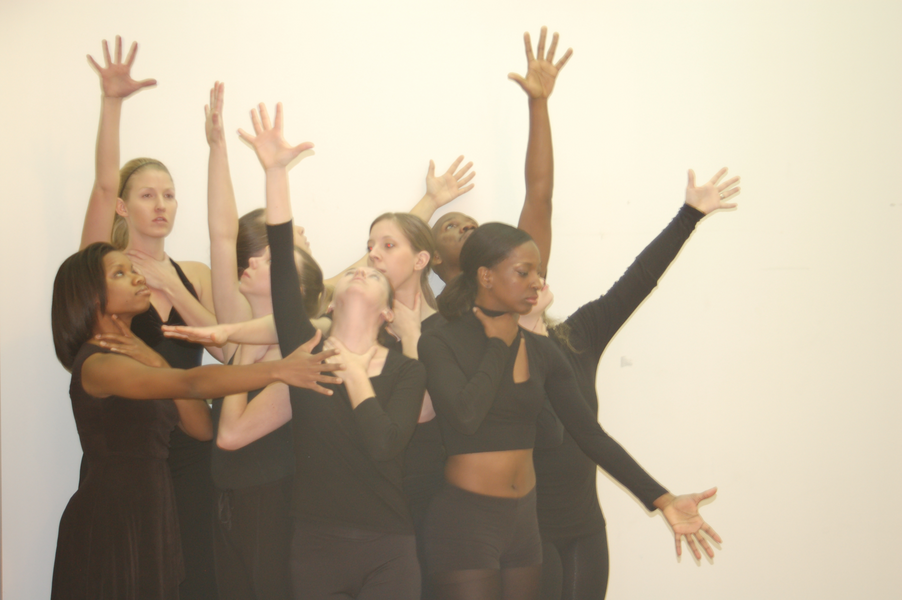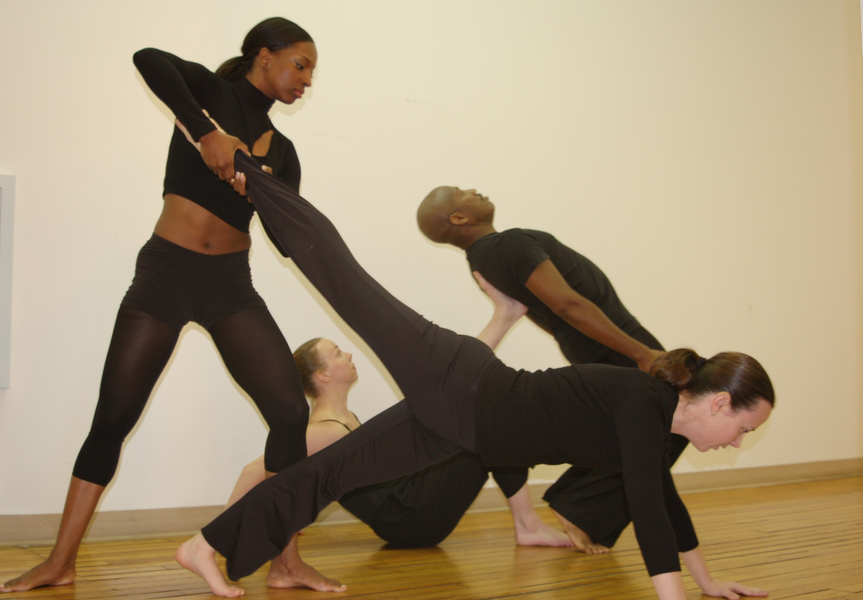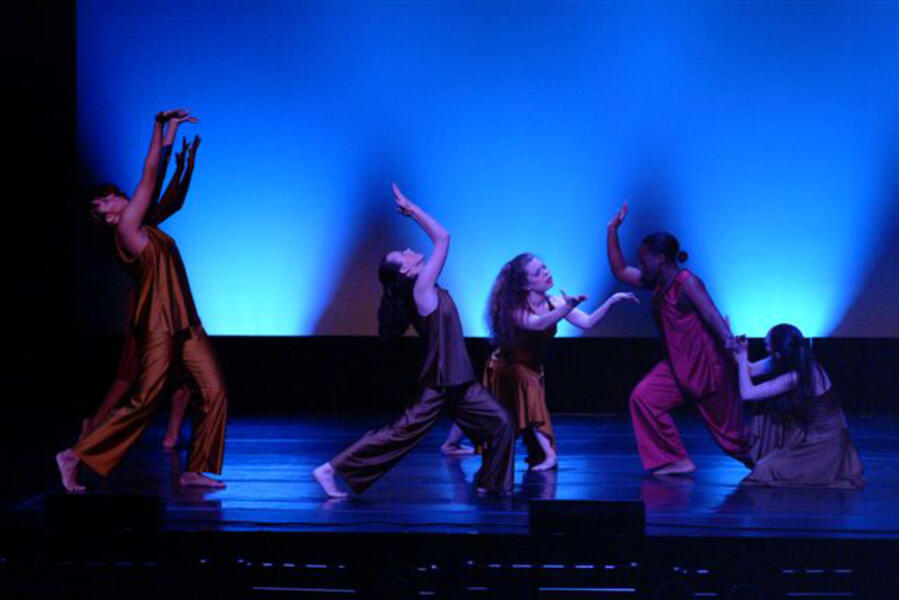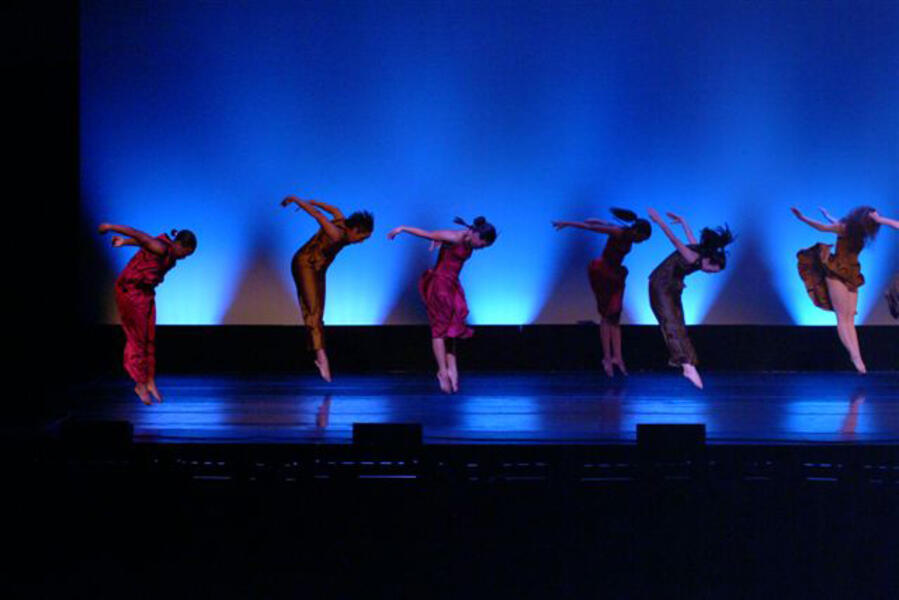Borders Uncrossed
Article written by Christina Royster-Hemby
Baltimore City Paper
Two lithe women--one black, one white--saunter toward each other from opposite ends of a well-lit room. As they meet in the center, their arms extend forward and they clutch each other by the throat. They hold this pose for a moment before reluctantly letting go and turning away, heading to opposite ends of the room. A few beats later, two different women--one black, one white--sail past each other, this time saying the words suggested by the dancers' movements: "I hate white people" and "I hate black people," each uttered with whispered, half-spit venom.
These exchanges were part of Full Circle Dance Company's latest program, Borders Uncrossed, which debuted at the Baltimore Museum of Art for Black History Month in 2007.
Racial differences are more about the ugly, deep-rooted ideas that are left unsaid, society writ large symbolized by the black and white dancers here. And even though Full Circle choreographed several dances for Borders Uncrossed to explore racial differences and suggest a path to racial dialogue, the dancers felt that at the end of the day the usual hatred will win out.
"This is a project we had fear about," said Donna Jacobs. "We're an interracial dance company," she says. "Do we have to bring in a facilitator to handle this [subject]? Would thoughts and latent opinions and experiences come out in our dance that would injure people?"
The project began when dancers were discussing topics for their next show. Madi Jackson, a Full Circle dancer and choreographer, suggested doing something on race. So the company, as it usually does, sponsored a community forum on race to inform their eventual dances.
Only about 20 people showed up, many of whom were Full Circle members. "Not everybody wants to talk about race," Jacobs says. "Many times people don't know how their opinions will be perceived by someone else. They don't know what is safe to say and how others will judge you based on what you said."
The members of Full Circle decided that, for this particular subject, conferring among the company was a more effective strategy. They talked about race in an intimate, familiar setting about racial slurs, misconceptions and stereotypes, interracial relationships, special treatment or the lack thereof. And what they found is that the more things change, the more they stay the same.
One of the younger company members shared with Jacobs how when she walks down her street one family stands outside and yells "nigger" as she walks by. An older member shared a story of his house being shot at by the Ku Klux Klan when he was a growing up 30 years ago. Some white members talked about growing up in all-white communities where they really didn't have to deal with race. These memories and stories showed up in their dances.
Jacobs said, "there have been moments when I have [asked myself], `Have I gone too far? Did I say too much? Was that last button the one I shouldn't have pushed?'" Jacobs added that when the dancers had to say hurtful things to one another she watched their body motions to see if such sentiments came through in their other movements.
"Deep Bayou," choreographed by Jacobs, was set to Nina Simone's "Four Women," and in it the dancers--some biracial, some black--danced in motions expressed their racial backgrounds. Their struggles were all different, but their dances were equally intense. In the dance's second section, a black dancer portrayed a character who is tired, weary, and near death from a long life of servitude.
"This project made us a more cohesive unit," said Liz Pelton. "We felt that we got a lot closer, even though we delved into these hard issues...individuals can learn a lot from each other and make progress."
Another dancer shared how skin color is an arduous road even within a family unit. April Lawyer, one of eight children, and her younger brother are the darkest-skinned of them all, and he uses foundation to lighten his skin. Lawyer added, "I wanted him to be aware that he's not alone. All of us are going through it."
And that's what Jackson and Jacobs meant when they said they fear that race is never going to go away. "They may shift and manifest in various ways, but I don't know if [racial issues] will ever go away," Jackson said, "which is the whole reason for the piece."
Article written by Christina Royster-Hemby
Baltimore City Paper
Two lithe women--one black, one white--saunter toward each other from opposite ends of a well-lit room. As they meet in the center, their arms extend forward and they clutch each other by the throat. They hold this pose for a moment before reluctantly letting go and turning away, heading to opposite ends of the room. A few beats later, two different women--one black, one white--sail past each other, this time saying the words suggested by the dancers' movements: "I hate white people" and "I hate black people," each uttered with whispered, half-spit venom.
These exchanges were part of Full Circle Dance Company's latest program, Borders Uncrossed, which debuted at the Baltimore Museum of Art for Black History Month in 2007.
Racial differences are more about the ugly, deep-rooted ideas that are left unsaid, society writ large symbolized by the black and white dancers here. And even though Full Circle choreographed several dances for Borders Uncrossed to explore racial differences and suggest a path to racial dialogue, the dancers felt that at the end of the day the usual hatred will win out.
"This is a project we had fear about," said Donna Jacobs. "We're an interracial dance company," she says. "Do we have to bring in a facilitator to handle this [subject]? Would thoughts and latent opinions and experiences come out in our dance that would injure people?"
The project began when dancers were discussing topics for their next show. Madi Jackson, a Full Circle dancer and choreographer, suggested doing something on race. So the company, as it usually does, sponsored a community forum on race to inform their eventual dances.
Only about 20 people showed up, many of whom were Full Circle members. "Not everybody wants to talk about race," Jacobs says. "Many times people don't know how their opinions will be perceived by someone else. They don't know what is safe to say and how others will judge you based on what you said."
The members of Full Circle decided that, for this particular subject, conferring among the company was a more effective strategy. They talked about race in an intimate, familiar setting about racial slurs, misconceptions and stereotypes, interracial relationships, special treatment or the lack thereof. And what they found is that the more things change, the more they stay the same.
One of the younger company members shared with Jacobs how when she walks down her street one family stands outside and yells "nigger" as she walks by. An older member shared a story of his house being shot at by the Ku Klux Klan when he was a growing up 30 years ago. Some white members talked about growing up in all-white communities where they really didn't have to deal with race. These memories and stories showed up in their dances.
Jacobs said, "there have been moments when I have [asked myself], `Have I gone too far? Did I say too much? Was that last button the one I shouldn't have pushed?'" Jacobs added that when the dancers had to say hurtful things to one another she watched their body motions to see if such sentiments came through in their other movements.
"Deep Bayou," choreographed by Jacobs, was set to Nina Simone's "Four Women," and in it the dancers--some biracial, some black--danced in motions expressed their racial backgrounds. Their struggles were all different, but their dances were equally intense. In the dance's second section, a black dancer portrayed a character who is tired, weary, and near death from a long life of servitude.
"This project made us a more cohesive unit," said Liz Pelton. "We felt that we got a lot closer, even though we delved into these hard issues...individuals can learn a lot from each other and make progress."
Another dancer shared how skin color is an arduous road even within a family unit. April Lawyer, one of eight children, and her younger brother are the darkest-skinned of them all, and he uses foundation to lighten his skin. Lawyer added, "I wanted him to be aware that he's not alone. All of us are going through it."
And that's what Jackson and Jacobs meant when they said they fear that race is never going to go away. "They may shift and manifest in various ways, but I don't know if [racial issues] will ever go away," Jackson said, "which is the whole reason for the piece."
-
 Borders UncrossedPictured: Company Photo courtesy of Erica Feriozzi
Borders UncrossedPictured: Company Photo courtesy of Erica Feriozzi -
 Borders UncrossedPictured: Hope Byers and Liz Pelton Photo courtesy of Erica Feriozzi
Borders UncrossedPictured: Hope Byers and Liz Pelton Photo courtesy of Erica Feriozzi -
 Deep BayouPhoto of company performing "Deep Bayou" as part of the Borders Uncrossed project Photo courtesy of Tisa Della Volpe "Love, grief, and sensuality play equal parts in this profoundly personal drama."
Deep BayouPhoto of company performing "Deep Bayou" as part of the Borders Uncrossed project Photo courtesy of Tisa Della Volpe "Love, grief, and sensuality play equal parts in this profoundly personal drama." -
 Deep BayouPhoto of the company performing "Deep Bayou" as part of the Borders Uncrossed project Photo courtesy of Tisa Della Volpe "Love, grief, and sensuality play equal parts in this profoundly personal drama."
Deep BayouPhoto of the company performing "Deep Bayou" as part of the Borders Uncrossed project Photo courtesy of Tisa Della Volpe "Love, grief, and sensuality play equal parts in this profoundly personal drama."



